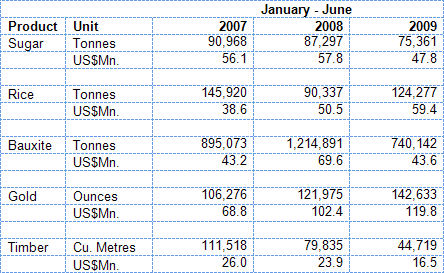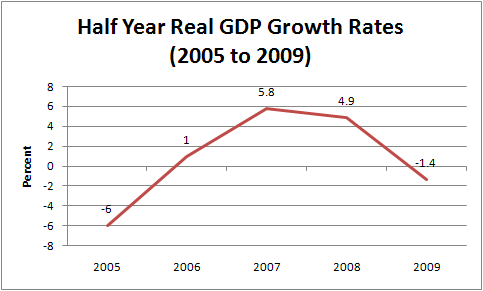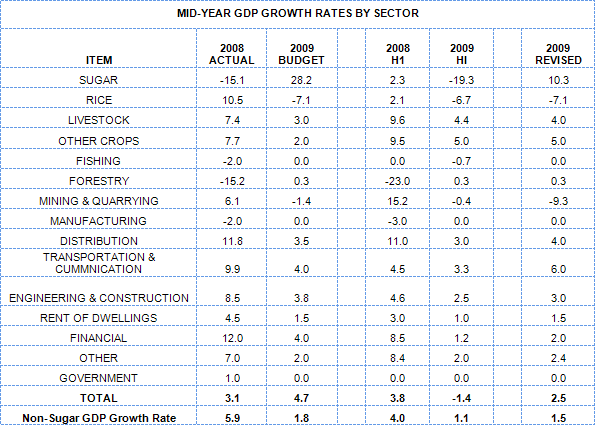Introduction
This is the third and penultimate instalment of a short series reviewing the mid-year financial and economic report presented last month by the Minister of Finance. This review has benefited and drawn from the half-year report presented to the Minister of Finance by the country’s central bank, the Bank of Guyana. We will also look at two developments this week – the two supplementary papers presented on Thursday to the National Assembly by the Finance Minister Dr Ashni Singh seeking another $4,677,208,405, roughly the equivalent of US$25M, some of which has already been spent. The other is the news that the state-owned sugar company is experiencing cash flow difficulties in meeting its payroll obligation, while also being the beneficiary of another $1.4B for its capital expenditure programme. The inability to meet one’s payroll obligation is one of the worst signs of serious financial difficulties a business can encounter, and one wonders how the corporation which is top heavy with accounting expertise did not foresee this and take preventive action.
This request for additional funding of roughly 5% of the 2009 budget is itself troubling since the Minister’s mid-year report had shown key ministries being unable to absorb and spend the money authorised by the National Assembly in the 2009 Budget. Readers will recall from last week that the key sectors identified by the Minister had only been able to spend 34.6% of the 2009 full-year budget allocation, compared with 38% in 2008. By way of an explanation for the capital expenditure in half-year 2009 falling behind schedule, the mid-year report identified “some delays as a result of logistical and other issues.”
A large proportion of the money is for areas controlled by President Jagdeo – the army and the burgeoning Office of the President. The current request brings to more than half a billion dollars the additional sums given to the GDF, an entity that is regularly reported as failing to meet proper standards of accountability. The Office of the President – Presidential Advisory will receive an additional $50M to meet expenditure in relation to the Office of Climate Change and the Low Carbon Development Strategy. It is uncertain whether this money will be reimbursed by our Norwegian benefactors under the Guyana-Norway LCDS MOU which provides for a possible grant to us in 2010 of US$30 billion Guyana dollars.
The Public Works Ministry which is one of the sectors whose expenditure is not on target is yet being given additional sums, while the $400M promised by the President to the rice sector is now part of those supplementary funds. Sugar, rice and electricity, three sectors with an all-pervasive government involvement are proving a heavy burden on the national coffers, raising serious doubts about the capacity of those sectors to deal with their apparent incessant problems, some of which may be weather related.
Let us return to the mid/half-year reports which include the following table of the country’s principal export commodities. While rice export is showing a substantial increase, half-year output in 2009 was 7% lower than in 2008, suggesting a substantially lower level of domestic consumption or lower stock levels at June 2009.
Exports of Major Commodities

Source: Bank of Guyana Mid-Year Report
The country’s import of merchandise also declined – by 16.2 per cent or US$104.3 million to US$538.5 million. This is partly attributed to a decline in import prices, mainly of fuel and food. While the decreases in other intermediate goods may not warrant major concern, that cannot be said for capital goods; the import of all categories of machinery declined by 16.1 per cent or US$21 million. What must be of concern, however, is the import of consumption goods which expanded by 7.6 per cent or $11.6 million primarily due to increases in other non-durables and motor car subcategories. We seem to have a mindless non-policy on vehicle imports, a significant proportion of which are for the growing band of contract employees and others in receipt of duty-free concessions, while the statistics highlight the increasingly visible extravagant lifestyles and conspicuous consumption of a fortunate few.
The Bank of Guyana report shows the extent to which Clico – the country’s largest insurance company has impacted on the economy. As a consequence of that failure, the total resources of the domestic insurance companies (life and non-life segments) declined by 34.7 per cent to G$25,640 million. The life component, which amounted to 64 per cent of the industry’s resources, fell by 46.8 per cent to G$16,321 million, whilst the non-life component rose by 8.8 per cent to G$9,319 million. The resources of the insurance companies are available for investment in other sectors of the economy but because of the surplus liquidity in the banking sector the impact has not been as strong on the rest of the economy. In respect of the savings and pensions of thousands of individuals – either held directly with Clico or indirectly through pension schemes – the impact has been dramatic if not visible.
This column has been strongly critical of the poor management and governance of Clico and the equally inadequate regulatory oversight that allowed the company to break all the rules. It also believes that more thought should have been given to saving the salvageable segments of the company. If the die has been cast and extreme unction has been administered, then there are compelling reasons for the payment of a first dividend to those with savings and pensions in Clico. What a good Christmas gift that would be.
In foreign exchange, net current transfers declined by 17.2 per cent to US$120.5 million as a result of lower inflows to the private sector in the form of worker remittances. The main sources of outflow were workers’ remittances and remittances to bank accounts, which amounted to US$54.4 million and US$29.7 million respectively. The issue of outward worker remittances highlighted in the Bank of Guyana report, amounting in the half-year to more than ten billion dollars is a serious development in the economy, but instead of addressing it, the Minister misrepresents the data in his own report.

Sources: Mid-Year Report 2009 and Bank of Guyana Half Year report
Once again the country is burdened with additional external and domestic debt. The total external public debt rose by US$27.2 million from December 2008 to US$861.5 million at end-June 2009 but it is the composition of the debt that must cause some concern. Over the past twelve months, the stock of outstanding public and publicly guaranteed debt rose by 11.3% to US$862 million with the IDB and the Venezuelans contributing equally to a $100 million in disbursements in the case of the IDB and trade credit by Venezuela under the Petrocaribe agreement. It must be a matter of speculation whether there is any co-ordination between those who manage our external affairs and those responsible for borrowing and spending.
Domestic debt continues its mountainous climb reaching $84 billion dollars in June 2009, an increase of 15% over the 12-month period and 11% during the first half of 2009. Ten years ago the total public bonded debt was $41.6 billion, meaning that over less than ten years the domestic debt has doubled, a situation that would have been replicated in the country’s external debt had it not been for debt-write off.
The reason for this is that what we cannot do by taxing, we do by borrowing – for anything and everything. To bring the New Building Society under the Financial Institutions Act requires the addition of just five words to the definition of a company subject to the licensing requirement of the FIA and the regulatory supervision of the Bank of Guyana. But in public finance and indeed in public management in Guyana, nothing is straightforward. We must have the obligatory consultant to come and tell us for tens of thousands of United States dollars how to do it. What a waste.
Next week we close this series by pulling the various strands together and looking for any cause for optimism in the economy and its management.


